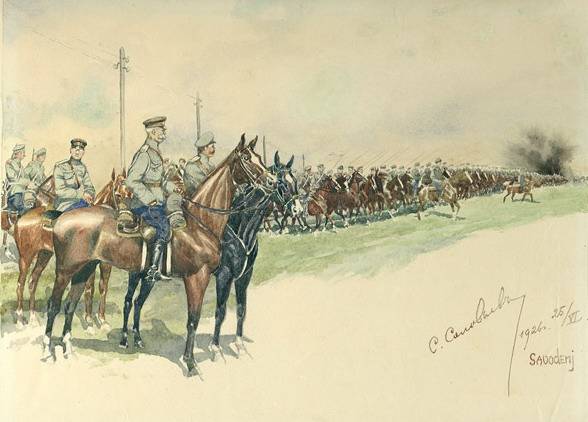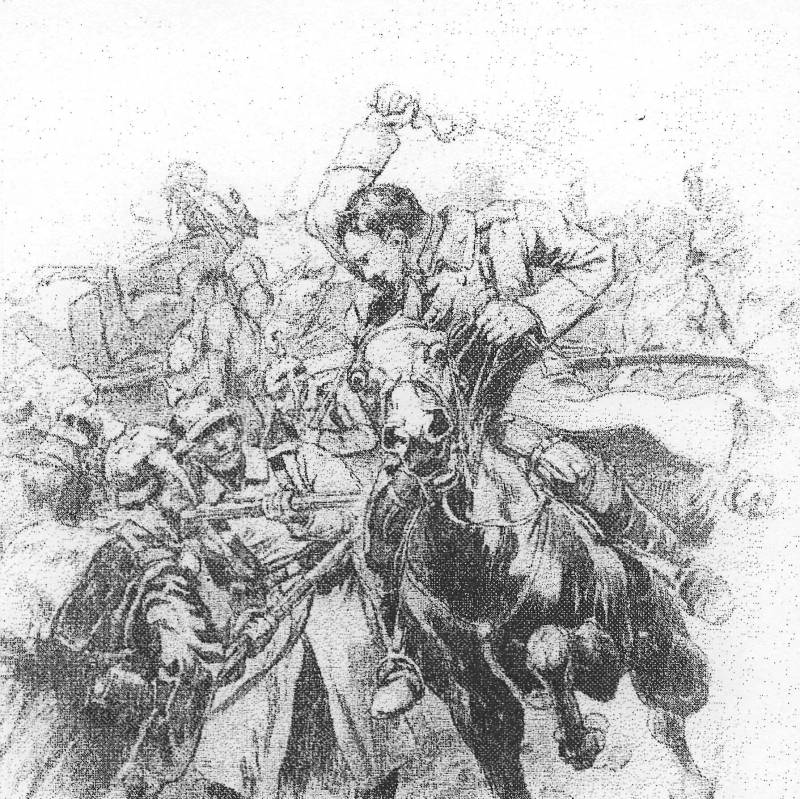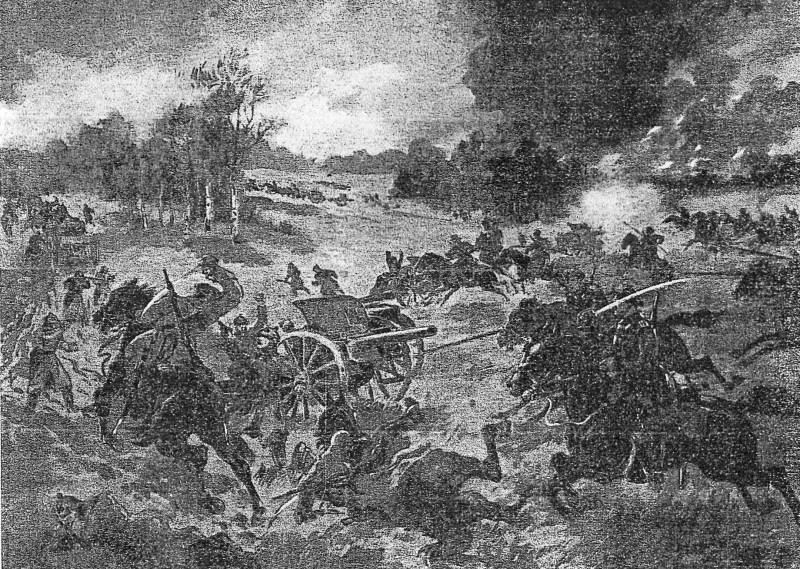Polish attack of Ukrainian hussars
Key events of this operation took place in Poland - primarily in the area of the city of Prasnysh.
The German assault force advanced into the gap that emerged in the combat structure of the Russian troops. The divisions of the 1-i reserve corps attacked Prasnysh: the 1-i reserve directly to the city, and the 36-i reserve - directly to the east.
To fill the dangerous gap, the Russian 1 and 2 th Siberian army corps and the 15 th cavalry division were put forward. The latter included the 15 th Hussar Ukrainian Her Imperial Highness the Grand Duchess Xenia Alexandrovna.
11 February Prasnysh, after fierce street fighting the garrison with the oppressive forces of the enemy, was taken by parts of the 1-th reserve division. But the advancing Germans were stopped by the troops of the 1 of Turkestan, the 19 of the army corps and the approaching Siberians. In this situation, the key task was to cover the connections of the 1 th reserve corps at Prasnysh, to defeat them. And the most important role was played by the actions of the Russian cavalry.
On the front of the attack of the Ukrainian hussars, units of the German 36-th Reserve Division acted - 69-I and 70-I reserve brigades.
Regiment poskadronno, under the fire of German artillery, was der. Nova Ves and concentrated in the village. Kozino. When the Siberian riflemen passed by the regiment that had prepared for the attack, the infantrymen joked about the hussar "cockade on boots" and the fact that the cavalry was "back in reserve". But they were joking for nothing.
Initially, it was decided to use the Ukrainian hussars as an infantry reserve for the advancing Siberians. Under artillery fire, dismounted squadrons were preparing to attack.
At this time, the chains of Siberian shooters from the village of Kozino were slowly moving forward, and from the side of the Augustvo farm, they were shelled by German batteries.
But it was obvious that it would be possible to “knock off” the German infantry from a position only with the help of a swift cavalry throw. And about five o'clock the regiment moved to the attack.

A rare picture appeared in the eyes of the witness: a powerful attack by Siberian shooters and hussar squadrons sweeping through their chains.
Seeing the hussars going on the attack, the arrows, already weary of the offensive, shouted "Hurray!" And when the cavalrymen caught up with their chains, some of the infantrymen, clutching at the stirrups, ran alongside or even climbed back to the grain of the horses. The hussar regiment intensified due to such a kind of "riding infantry."
The enemy, at the sight of the rapidly advancing cavalry, began to withdraw.
3-th squadron, passing d.d. Zbika Gavronki and Zbika Belke, went to the village. Gostkovo - despite the losses from the fire of German infantry entrenched in ditches, and then rushed to the forest north of the farm Avgustovo, where he was also met with strong rifle fire. There were shouts of "Hurray" and intense firing by the retreating groups and the German infantrymen alone.
1-th squadron passed through the farm Avgustovo, capturing prisoners, and continued movement through the forest. Lieutenant Kryzhanovsky, who overcame a forest at the head of a platoon, located east of vil. Emovo, found a whole column of German infantry, moving to the village. Dobrzhankovo. Having decided, because of his short-sightedness and darkness, that these were Siberian arrows, the officer calmly went to the infantry. The Germans opened fire. Shouting - "Ruby!", The lieutenant rushed forward, first crashing into the column. Hussars rushed after him, shouting “Hurray!” And the infantrymen began to throw their rifles and surrender.
Il 1. Attack of cavalry, 1915, Mr. N. Samokish.
The 3 squadron of the regiment broke into the village of Gostkovo. The mill, located on the northern outskirts of the village, was occupied by German soldiers who opened fire on the hussars. Then the cornet squadron Appelgren hurried his hussars. The cavalrymen surrounded the mill, and then several soldiers climbed up its walls and opened fire on the windows. The rest of the hussars rushed to storm the building. As a result, part of the Germans surrendered in captivity, and part was perekolot.
The greatest success in this battle was achieved 2-m squadron. His non-commissioned officer Khorkov with several soldiers rushed to the village. Lisoguru, where the hussars learned from the residents that a German artillery battery had just passed through the village. Hussars rushed after the already levitated horses. Seeing the cavalrymen, the German artillerymen began to remove the guns from the front and prepare for battle. They managed to remove three guns from the front, and only one of them managed to shoot, as the hussars flew. The gunners defended themselves fiercely, firing from their personal weapons - but their fate was decided. Several hussars captured 26 artillerymen.
Il 2. The capture by the Ukrainian hussars of the German battery near Prasnysh.
Already at full dusk, moving forward, the hussars on the way ran into the 105-mm gun stuck in the mud. Gunners fumbled around the gun, trying to replace a broken wheel on the front end. Another artillery trophy hit the hussar’s hands. This is the very 105-mm gun, lost by the Germans under Prasnysh, which is mentioned in the materials of the German Reich Archives [Reichsarchiv. Der Weltkrieg 1914 - 1918. Band 7. Winter und Frühjahr 1915. Berlin, 1931. S. 257].
In this reckless battle, the 15 th Ukrainian Hussars regiment suffered the following losses: the 27 man was killed (including the officer) and the 22 man was wounded. Three 77-mm and one 105-mm guns, 6 charging boxes and 256 prisoners with 4 officers became trophies of the regiment.
But not only Ukrainian hussars were active during the Second Prasnysh operation. The Cossacks fought successfully in the Prasnysh battles. Thus, the 6 th Siberian Cossack regiment captured 700 man, the 2 th Ural Cossack regiment - almost as many (and the German prisoners were from five different infantry battalions), and before the 1000 man - 3 th Ural Cossack regiment.
In total, 23 squadrons and hundreds of Russian cavalry participated in equestrian attacks near Prasnysh. If the Russian cavalry achieved something, then the German one did nothing - von Hollen's cavalry corps modestly hid in the rear.
Thus, the 12 of February, the 15 of the hussar Ukrainian regiment carried out one of the most brilliant equestrian attacks in its stories. This is a very indicative combat episode with the use of an attack in the equestrian system — and against the attacking infantry of the enemy — for which the Russian cavalry was famous during the years of the world war.
Russian cavalry under Prasnyshem fulfilled an important operational task. In the course of the Second Prasnysh operation, the consequences of the Second August operation were leveled, and the operational and strategic position on the theater of operations was stable and durable.


Information